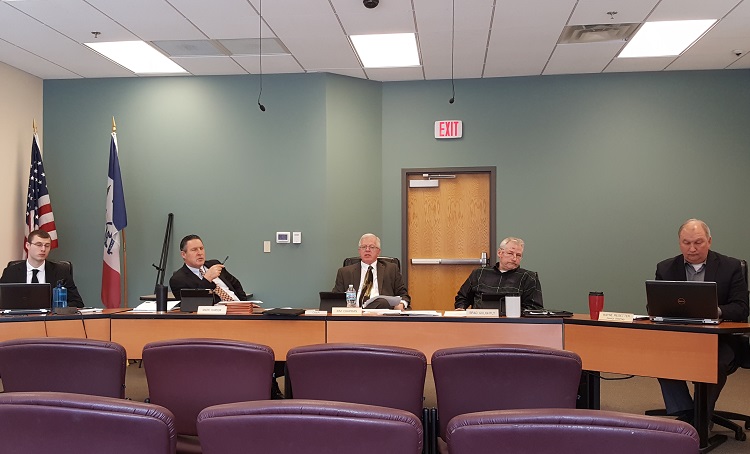
The number is wrong, but it is the official number all the same.
That is one of the provisional conclusions to emerge from inquiry into the clerical error that dropped 5,842 votes from the final tally of Dallas County ballots in the 2016 general election.
“Because the official canvass has taken place, there’s nothing that can be done to change the official numbers,” according to Kevin Hall, communications director for Iowa Secretary of State Paul Pate. “That’s my understanding of it.”
The Dallas County Board of Supervisors certified the incorrect results for the general election Nov. 15 in the county’s official abstract of the election, and the Iowa Board of Canvass in turn certified the incorrect statewide results Dec. 5.
The omitted absentee ballots amounted to about 13 percent of the 44,430 votes cast in Dallas County in the Nov. 8 election, according to Dallas County Auditor and Commissioner of Elections Julia Helm.
The secretary of state’s office discovered the discrepancy in “late January,” Hall said, and informed Helm’s office about the error Feb. 1.
The unreported votes made no difference in the outcome of any federal, state or county race. The same winners would have won even if the votes were counted.
In order to correct the procedures that made a human error possible in the November election and to minimize the risk of errors in the future, Helm brought of plan of action to the board of supervisors Tuesday.
“Due to the error that was found in the results of the 2016 general election,” Helm said, “we are asking the board to help us convene an election review commission.”
In Helm’s plan, the supervisors would appoint a commission Feb. 21 composed of two Democrats and two Republicans, with one of the Democrats and Republicans coming from the Special Precinct Board. The commission would meet and produce a report for the supervisors by Feb. 28.
“We will convene a review of the materials and the missing absentees,” Helm said, “and have those proceedings brought back to the board to review. We just thought for transparency and public confidence, we should bring people from the outside in to look at this.”
Helm said she “touched base with the secretary of state on this, and they gave us full approval” for the election review commission.
Supervisor Mark Hanson asked whether the county would then amend its official canvass in light of the commission’s findings by replacing the wrong numbers with the correct ones.
“We have no authority to recanvass or recount,” Helm said. “We’ve been told that very explicitly.”
Dallas County Attorney Wayne Reisetter said the Iowa Secretary of State Paul Pate is discussing the situation with the Iowa Attorney General Tom Miller, and “the secretary of state agrees so far that there is not a provision to correct the canvass. The legislature simply has not provided an avenue to correct the official record from fault as far as we know.”
In the meantime, Helm said, while the state authorities weigh the question, the best the county can do is to add a “supplement” to its official canvass.
“From this report from this commission, we can add their findings to our supplemental to the canvass,” she said. “I cannot call it a recanvass. I cannot call it a recount. I can just add it supplementally. That’s directly from the secretary of state’s telling me that.”
The supervisors approved Helm’s plan for a election review commission.
At the state level, Pate is using the Dallas County situation to seek authorization for “post-election audits” in his Election Integrity Act now before the Iowa Legislature.
“I am asking the Iowa Legislature to give me the authority to conduct them,” Pate said last week. “A post-election audit in Dallas County would have caught and fixed this problem” and “would help ensure things like what happened in Dallas County never happen again.”
The Iowa State Association of County Auditors recently voted to oppose Pate’s proposed Elections Integrity Bill.
Hall said he was not sure how Pate’s office discovered the error or who discovered it.
“It was caught by our office, but it wasn’t during an audit process,” Hall said. “I’m not sure exactly how they detected it, but somebody was overlooking the numbers and noticed the discrepancy and did further digging and then pointed it out to the Dallas County Auditor.”
The error was spotted by “someone in our elections division,” Hall said. “I probably need to get more details on that. I’m not sure exactly how they came across it.”
Pate’s office issued a technical infraction to the Dallas County Auditor’s office as a result of the error, “which is basically just a written reprimand,” Hall said. “We believe it was human error. It was a bad error to make, but we’re taking to steps to make sure something like that doesn’t happen again.”
The 2016 general election was the last conducted under the authority of the previous Dallas County Auditor and Commissioner of Elections Gene Krumm, who retired Dec. 31. Helm, formerly deputy auditor, was on the ballot and so recused herself from all election-related activities.
Election rigging has been on the minds of many voters since the 2016 general election due to claims of voter fraud made by U.S. President Donald J. Trump, who lost the popular vote to the Democrat candidate, Hillary Clinton.
In the case of Dallas County, rigging appears to be ruled out, but Supervisor Hanson noted some “controversy” and “innuendo” attaching to this “Dallas County election scandal,” as some observers have called it.
“If someone was out to commit fraud,” Hall said, “they would have changed the results, I would think. We don’t think there was any ill intent here, but it was a serious error.” He said it is “really up to the county attorney to determine if they want to do further investigation on it. We believe it was human error.”
What if the unreported votes had brought to office one or more losers, as in the case of Trump? What legal and political fallout might have followed?
“I would hate to speculate on that,” Hall said. “We’re just glad that it did not happen.”


















